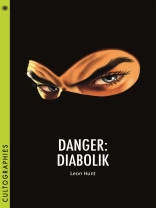Danger: Diabolik (1968) was adapted from a comic that has been a social phenomenon in Italy for over fifty years, featuring a masked master criminal—part Fantômas, part James Bond—and his elegant companion Eva Kant. The film partially reinvents the character as a countercultural prankster, subverting public officials and the national economy, and places him in a luxurious and futuristic underground hideout and Eva in a series of unforgettable outfits. A commercial disappointment on its original release, Danger: Diabolik’s reputation has grown along with that of its director, Mario Bava, the quintessential cult auteur, while the pop-art glamour of its costumes and sets have caught the imagination of such people as Roman Coppola and the Beastie Boys.
This study examines its status as a comic-book movie, including its relation both to the original fumetto and to its sister-film, Barbarella. It traces its production and initial reception in Italy, France, the U.S., and the UK, and its cult afterlife as both a pop-art classic and campy ‘bad film’ featured in the final episode of Mystery Science Theatre 3000.
สารบัญ
Acknowledgements
Introduction: Diabolik, chi sei?
1. From fumetto nero to ‘wild and kooky cape-opera’: Production, promotion, initial reception
2. ‘Uh-oh – it’s getting groovy!’: The cult afterlife of Danger: Diabolik
3. Fantômas all’italiana: Analysis
4. Genius of Crime: The place of the film
Notes
Bibliography
Index
เกี่ยวกับผู้แต่ง
Leon Hunt is a senior lecturer in film and TV studies at Brunel University. He is the author of
British Low Culture: From Safari Suits to Sexpolitation (1998),
Kung Fu Cult Masters: From Bruce Lee to Crouching Tiger (2003), and
Cult British TV Comedy: From Reeves and Mortimer to Psychoville (2013).












